Hurghada Red Sea Egypt in 2026 is one of the most dazzling and dyna...

The Pharaonic civilization in Egypt has always been a subject of fascination, especially since Egyptian culture differed greatly from the cultures of other civilizations. The ancient Egyptians adopted gods that were mostly representations of the natural and social phenomena they experienced.
Many studies indicate that the ancient Egyptians worshiped more than 1,500 gods. Although the number of the ancient Egyptian god statues is not precisely known, there are some famous gods in the Pharaonic civilization that we talk about in detail in this article.
The ancient Egyptian god statues are numerous, but there are 10 famous statues of these gods, each of which refers to a specific phenomenon or a specific symbol, whether social or natural. They are as follows:
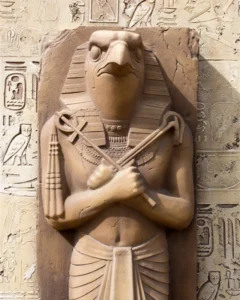
Ra
The god Ra is the sun god of the ancient Egyptians and was symbolized by the sun disk. Ra was one of the ancient Egyptian gods in the era of the Fifth Dynasty, which extended between the 24th and 25th centuries BC. This god was worshiped in the city of Heliopolis in the north, and his temples were in Ain Shams and Abu Sir, two cities in Egypt.
After that, the worship of the god Ra reached the city of Thebes, and a large number of temples were built for him there. King Ramses II, one of the most famous pharaohs, built the Abu Simbel Temple for the god Ra, and this temple is the most famous temple in Egypt ever and contains the statue of the god Ra, one of the most famous ancient Egyptian god statues ever.
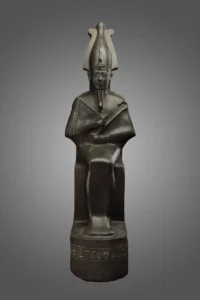
Osiris
Osiris is the god of resurrection and judgment among the ancient Egyptians, and his statue is one of the main ancient Egyptian god statues. He married his sister Isis. There are some legends that say that Osiris was the first Egyptian king to rule in prehistoric times. Osiris is one of the most famous gods of the ancient Egyptians due to his legendary story, where he was killed by his evil brother Set, then cut into pieces and thrown into the Nile River.
The ancient Egyptian legend says that Isis began searching everywhere for her husband’s body until she brought him back to life and gave birth to their son Horus. According to these stories, because Osiris was able to come back to life, the Egyptians gave him the title of the god of resurrection and judgment and believed that he would judge the dead in the afterlife.
The statue of Osiris in the Egyptian Museum depicts King Osiris sitting on the throne in a mummified form and holding his royal staff. This statue of the god Osiris was found with two accompanying statues, one of the goddess Isis and the other of the goddess Hathor.
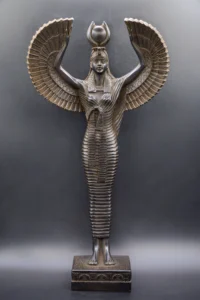
Isis
Isis is one of the main deities in the ancient Egyptian religion who revived her slaughtered husband Osiris and gave birth to Horus. The worship of Isis spread throughout the Greco-Roman world, and she and her husband Osiris became the most worshiped in the first millennium BC. Many temples were built for her, the most famous of which is the Temple of Philae.
The statue of Isis in the Egyptian Museum is made in the form of a winged woman. The ancient Egyptians believed that Isis and her sister Nephthys became winged while searching for the body of Osiris and then brought him back to life in the same form.
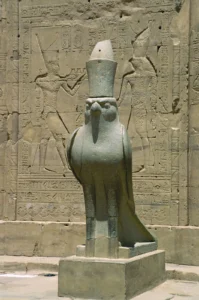
Horus
Horus is one of the most important ancient Egyptian god statues and symbolizes goodness and justice. He is the son of Isis and Osiris. In ancient Egyptian mythology, Horus took revenge on his evil uncle Set, who killed his father and distributed his body parts in the Nile River. When Horus grew up, a battle took place between him and his uncle Set, and he won, but he lost his left eye, and then took the throne of Egypt.
The ancient Egyptians took Horus as a role model because he was able to avenge his father. The ancient Egyptians believed that Horus in the afterlife would be the one who would present the dead to his father Osiris to judge them. A huge statue of the god Horus was discovered inside the remains of the hypostyle hall in a temple belonging to King Amenhotep III in the Kom el-Hettan area on the West Bank of Luxor. The statue is made of black granite in the form of a falcon.
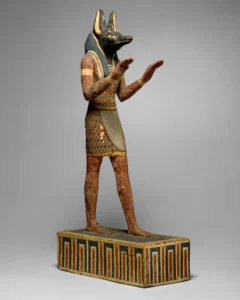
Anubis
Anubis is the name of the god of death and mummification in ancient Egypt. The name Anubis is always associated with tombs in ancient Egyptian civilization and is described as being responsible for mummification. He was the god of the afterlife before being replaced by Osiris during the Middle Kingdom to guide souls in the afterlife, according to the ancient Egyptians.
They believed that Anubis protected the tombs, as he protected the body of Osiris from his brother Set, who tried to attack the body. The Egyptians also believed in the myth of Isis and Osiris that Anubis helped Isis mummify Osiris. The statue of Anubis is a statue with the face of a dog or wolf and the body of a human, symbolizing one of the dog species that were known in ancient Egypt.
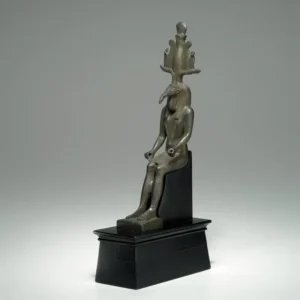
Thoth
The god Thoth in ancient Egyptian religion is the god of the moon and science, who taught them writing and arithmetic. He is always depicted holding a pen and a tablet on which he writes. The ancient Egyptians believed that Thoth’s role in the afterlife was to weigh the heart of the deceased in front of the feather of truth, Maat, and then record the result of the scale.
The god Thoth has always been associated with the Egyptians’ ability to know the calendar, the days of the year, and the months. The first month of the ancient Egyptian year was named after him. A 4-meter-tall statue of Thoth made of red granite was discovered in May 2010 on the remains of the temple of King Amenhotep III in Luxor, becoming one of the most important ancient Egyptian god statues.
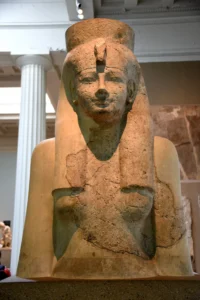
Hathor
The goddess Hathor is the goddess of the sky, love, beauty, and happiness among the ancient Egyptians. The ancient Egyptians usually depicted her in the form of a cow at times, and at other times in the form of a woman with cow ears and horns.
The ancient Egyptians believed that Hathor was the one who sheltered Horus, the son of Isis and Osiris, breastfed him, and protected him. Therefore, her statue in the form of a cow is one of the most famous ancient Egyptian god statues.
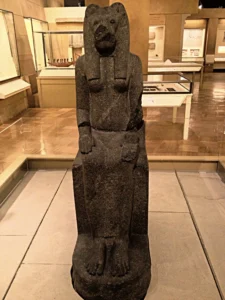
Sekhmet
Sekhmet is one of the goddesses in the ancient Egyptian religion. She was called the great lady, beloved of Ptah. The statue of Sekhmet is always depicted as a woman with the head of a lioness, a sun disk, and a cobra on her head. Her cult center is in Memphis, and she is the wife of Ptah and the mother of Nefertum. They represented the Memphis triad.
In ancient Egyptian mythology, the sun god Ra was angry with humans and sent Sekhmet to take revenge on them.
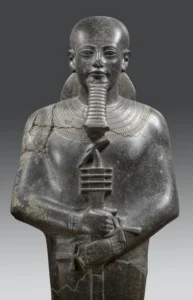
Ptah
The god Ptah was believed by the ancient Egyptians to be the creator god who lived before anything else and created this world. The statue of Ptah is one of the most important ancient Egyptian god statues, as he appears as a shrouded, bearded man.
The ancient Egyptians also believed that Ptah embodied himself in the Apis bull. The ancient Egyptian religion united the god Ptah with the god Sokar. The statue of Ptah is in the Egyptian Museum along with a large number of ancient Egyptian god statues.
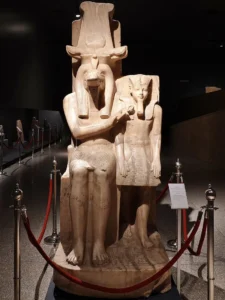
Sobek
The ancient Egyptians revered crocodiles until they had the god Sobek, who symbolized the crocodiles in the Nile River. The ancient Egyptians believed that the god Sobek restored fighters in battles or the dead to their former physical health. In Luxor, there is the Temple of Sobek, which contains a number of rare ancient Egyptian god statues, including the statue of King Amenhotep III.
The statue sits in the form of a crocodile head and a human body, wearing a crown and holding the key of life in its right hand. This statue is considered one of the most beautiful ancient Egyptian god statues ever.
The ancient Egyptian god statues have always been a source of amazement and wonder for many. This is, of course, due to the large number of gods that the ancient Egyptians worshiped, and each god had a special meaning. In this article, we talked about the 10 best ancient Egyptian god statues.
We offer tours to Egypt’s most famous destinations such as the Pyramids and Sphinx in Giza, Karnak Temple and Luxor, Valley of the Kings, Sharm El Sheikh and Hurghada for beaches and diving, and Alexandria.
We provide organized tours, luxury hotel and resort bookings, comfortable transportation services, experienced tour guides, and activity ticket bookings such as diving, desert safaris, and Nile cruises.